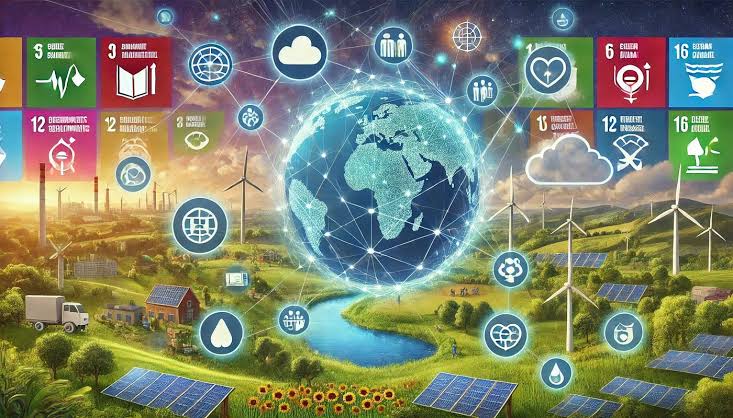The United Nations introduced the Sustainable Development Goals (SDGs) in 2015 as a blueprint to tackle global challenges such as poverty, inequality, climate change, and environmental degradation. With 17 interconnected goals, the SDGs aim to create a more sustainable and equitable world by 2030. Technology has emerged as a critical driver of progress in this mission, offering innovative solutions to complex global issues. From artificial intelligence to renewable energy and digital connectivity, technology continues to play a transformative role in accelerating global sustainability efforts.
Advancing Quality Education through Digital Tools
One of the major SDGs is ensuring inclusive and equitable quality education for all. Technology has significantly expanded access to learning through online platforms, virtual classrooms, and mobile applications. Children and adults in remote regions can now access quality educational resources via smartphones and affordable internet connections.
E-learning platforms, open-source content, and AI-driven tutoring systems help bridge knowledge gaps. Technologies like virtual reality and gamified learning also enhance engagement, making education more interactive and inclusive. By reducing geographical and financial barriers, technology directly supports the goal of lifelong learning opportunities for all.
Enhancing Healthcare Access and Innovation
Health and well-being are central to sustainable development, and digital health technologies are helping bridge healthcare inequalities. Telemedicine platforms now enable remote consultations, reducing the need for physical visits and ensuring access in underserved regions. Wearable devices and mobile health apps track vital signs, helping individuals monitor their health and adopt preventive care.
Artificial intelligence is being used in medical research to detect diseases earlier and support faster drug development. Robotics and data analytics are also reshaping surgery, diagnostics, and hospital management. These advancements help address SDG 3, which focuses on ensuring healthy lives and promoting well-being.
Promoting Clean Energy and Climate Action
Technology plays a vital role in supporting affordable and clean energy, a core SDG that links directly to climate action. Renewable energy technologies such as solar panels, wind turbines, and hydropower systems have become more efficient and affordable due to advancements in engineering and digital monitoring.
Smart grids and energy storage technologies help optimize the use of renewable power and reduce reliance on fossil fuels. Additionally, digital platforms powered by AI and blockchain are improving transparency in carbon trading and renewable energy distribution. These innovations contribute to reducing global carbon footprints and combating climate change.
Driving Economic Growth and Innovation
Technology is central to fostering inclusive economic growth, industrial development, and innovation. Digital platforms have created new opportunities for entrepreneurship, enabling small businesses and startups to reach global markets. E-commerce, mobile payment systems, and digital financial tools are helping to lift people out of poverty by increasing financial inclusion.
Automation, artificial intelligence, and robotics are transforming industries, creating more efficient production processes while reducing resource waste. At the same time, technology fosters new job opportunities in digital sectors, supporting the goal of decent work and economic growth.
Building Sustainable Cities and Infrastructure
Urbanization presents both opportunities and challenges for sustainable development. Technology is helping cities become smarter and more sustainable by integrating solutions such as intelligent traffic management, smart lighting systems, and waste management technologies.
The use of the Internet of Things (IoT) allows cities to monitor air quality, water distribution, and energy consumption, helping reduce environmental strain. Furthermore, advanced construction technologies and green building designs contribute to resilient infrastructure, aligning with SDG goals related to sustainable cities and communities.
Supporting Responsible Consumption and Production
Technology is enabling businesses and individuals to adopt more sustainable consumption patterns. Artificial intelligence and big data help companies track supply chains, reduce waste, and adopt circular economy practices. For example, sensors and tracking technologies can monitor food supply chains to reduce spoilage and waste.
Digital platforms also educate consumers about sustainable practices, from eco-friendly products to carbon footprint calculators. By promoting transparency and accountability, technology encourages individuals and corporations to make responsible choices that support global sustainability goals.
Advancing Gender Equality and Social Inclusion
Technology is a powerful tool for promoting gender equality and social empowerment. Digital platforms provide women and marginalized communities with access to education, financial services, and entrepreneurial opportunities. Mobile banking, e-learning platforms, and telemedicine services have particularly helped women in rural and underserved regions.
Additionally, social media campaigns and digital advocacy platforms raise awareness about gender equality, human rights, and social inclusion. These advancements support SDG 5 and foster a more inclusive global society.
Protecting Ecosystems and Biodiversity
Technology also contributes to environmental sustainability by helping monitor and protect ecosystems. Drones and satellite imagery track deforestation, illegal mining, and wildlife poaching. Artificial intelligence systems analyze environmental data to predict risks, while digital mapping tools assist in planning conservation projects.
Blockchain technology is being used to ensure transparency in the trade of natural resources and to support sustainable fishing and forestry. These digital innovations contribute to the conservation of biodiversity and the protection of natural ecosystems.
Strengthening Global Partnerships through Connectivity
The SDGs emphasize global cooperation, and digital connectivity plays a major role in building international partnerships. Cloud computing, video conferencing, and collaboration platforms have connected governments, NGOs, and businesses across borders. These digital tools facilitate knowledge sharing, policy coordination, and joint action on sustainability issues.
Technology also supports data collection and reporting, which is essential for measuring progress toward the SDGs. Platforms that track development indicators help governments and organizations make informed decisions and allocate resources effectively.
Conclusion
Technology is not just an enabler but a cornerstone of sustainable development across the globe. From education and healthcare to clean energy and climate action, digital tools and innovations are accelerating progress toward the United Nations’ SDGs. By empowering individuals, strengthening communities, and creating efficient systems, technology addresses some of the most pressing global challenges.
However, it is crucial to ensure equal access to technology, bridge the digital divide, and prioritize ethical use. With responsible deployment, technology will continue to support a more sustainable, inclusive, and resilient future for all.



